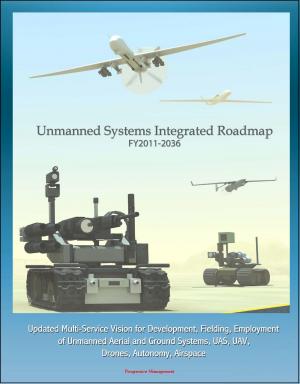Cyber Operations and the Warfighting Functions - USCYBERCOM, Cyber Attacks and Cyber War, Distributed Denial of Service attack (DDoS), SCADA, Russian and Georgian Conflict, Hacktivism
Nonfiction, Computers, Networking & Communications, Computer Security, Operating Systems, Application Software| Author: | Progressive Management | ISBN: | 9781310564222 |
| Publisher: | Progressive Management | Publication: | October 6, 2014 |
| Imprint: | Smashwords Edition | Language: | English |
| Author: | Progressive Management |
| ISBN: | 9781310564222 |
| Publisher: | Progressive Management |
| Publication: | October 6, 2014 |
| Imprint: | Smashwords Edition |
| Language: | English |
In 2005, the Department of Defense recognized cyberspace as the fifth operational domain. In 2009, the Commander of U.S. Strategic Command directed the creation of U.S. Cyber Command on the heels of recently reported cyber attacks against Estonia and Georgia. These cyber attacks negatively affected the state's ability to provide effective governance. Sovereign nations across the world took notice. Cyber terrorism, at best cyber hacktivism, had crossed the threshold to embody what most consider acts of war. This strategic research paper utilizes the Estonia and Georgia cyber attacks to observe how cyber forces draw on the joint functions like a Brigade Combat Team or Air Expeditionary Wing uses the functions in their respective domains. The paper briefly describes cyber criminal activity, cyber hacktivism, and cyber terrorism to differentiate those activities from offensive cyber operations. The paper succinctly discusses U.S. Cyber Command's three mission areas, further defining the discipline of military offensive cyber operations. The paper then explores how Joint Force Commanders may utilize the joint warfighting functions depicted in Joint and Army doctrine to integrate and synchronize offensive cyber operations.
The cyber attacks on Estonia and Georgia negatively affected their ability to provide effective governance. Nations across the world took notice. Cyber terrorism, or at best cyber hacktivism, had crossed the threshold to embody what most sovereign nations consider acts of war. The Estonia and Georgia cyber attacks were not happenstance events, rather planned, integrated, and synchronized operations to achieve intended effects. The joint functions / warfighting functions provide an operational framework for Joint Force Commanders (JFC) to coordinate, integrate, and synchronize cyber operations. The ensuing analysis illustrates that cyber operations share many of the same qualities as the more traditional operations in the land, sea, air, and space domains. But, before any analysis can begin, we must review a few key actions the military has taken over the last ten years, define what constitutes cyberspace, and understand how cyber operations differs from cyber crimes, cyber hacktivism, and cyber terrorism.
In 2005, the Department of Defense (DoD) recognized cyberspace as the fifth operational domain, a move that brought cyber operations from a largely supporting effort into an operational space equal to the land, sea, air, and space domains.2 Cyber operations certainly existed prior to 2005, but in the past decade, the United States Government has become increasingly more reliant on cyberspace to manage its governance responsibilities. The Executive Branch's International Strategy for Cyber Space defines the importance of cyberspace stating, the "Digital infrastructure is increasingly the backbone of prosperous economies, vigorous research communities, strong militaries, transparent governments, and free societies."3 However, America's cyberspace reliance creates strategic weaknesses our governmental leaders must address and mitigate. The cyber attacks on Estonia and Georgia only serve to highlight these strategic vulnerabilities.
In 2005, the Department of Defense recognized cyberspace as the fifth operational domain. In 2009, the Commander of U.S. Strategic Command directed the creation of U.S. Cyber Command on the heels of recently reported cyber attacks against Estonia and Georgia. These cyber attacks negatively affected the state's ability to provide effective governance. Sovereign nations across the world took notice. Cyber terrorism, at best cyber hacktivism, had crossed the threshold to embody what most consider acts of war. This strategic research paper utilizes the Estonia and Georgia cyber attacks to observe how cyber forces draw on the joint functions like a Brigade Combat Team or Air Expeditionary Wing uses the functions in their respective domains. The paper briefly describes cyber criminal activity, cyber hacktivism, and cyber terrorism to differentiate those activities from offensive cyber operations. The paper succinctly discusses U.S. Cyber Command's three mission areas, further defining the discipline of military offensive cyber operations. The paper then explores how Joint Force Commanders may utilize the joint warfighting functions depicted in Joint and Army doctrine to integrate and synchronize offensive cyber operations.
The cyber attacks on Estonia and Georgia negatively affected their ability to provide effective governance. Nations across the world took notice. Cyber terrorism, or at best cyber hacktivism, had crossed the threshold to embody what most sovereign nations consider acts of war. The Estonia and Georgia cyber attacks were not happenstance events, rather planned, integrated, and synchronized operations to achieve intended effects. The joint functions / warfighting functions provide an operational framework for Joint Force Commanders (JFC) to coordinate, integrate, and synchronize cyber operations. The ensuing analysis illustrates that cyber operations share many of the same qualities as the more traditional operations in the land, sea, air, and space domains. But, before any analysis can begin, we must review a few key actions the military has taken over the last ten years, define what constitutes cyberspace, and understand how cyber operations differs from cyber crimes, cyber hacktivism, and cyber terrorism.
In 2005, the Department of Defense (DoD) recognized cyberspace as the fifth operational domain, a move that brought cyber operations from a largely supporting effort into an operational space equal to the land, sea, air, and space domains.2 Cyber operations certainly existed prior to 2005, but in the past decade, the United States Government has become increasingly more reliant on cyberspace to manage its governance responsibilities. The Executive Branch's International Strategy for Cyber Space defines the importance of cyberspace stating, the "Digital infrastructure is increasingly the backbone of prosperous economies, vigorous research communities, strong militaries, transparent governments, and free societies."3 However, America's cyberspace reliance creates strategic weaknesses our governmental leaders must address and mitigate. The cyber attacks on Estonia and Georgia only serve to highlight these strategic vulnerabilities.















